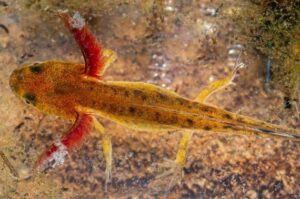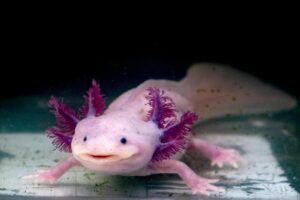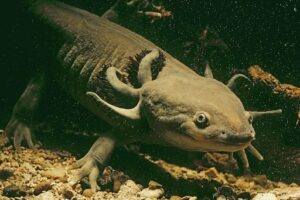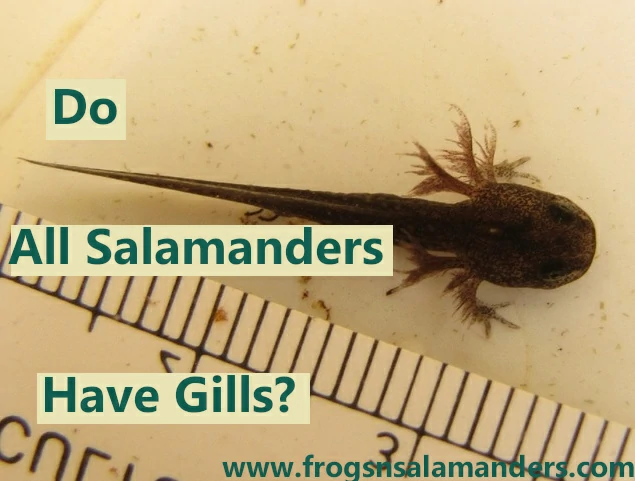Salamanders are amazing little animals that many people find interesting. They belong to a group called amphibians, just like frogs and toads. But salamanders look quite different from frogs. They have long bodies, tails, and smooth, wet skin. You’ll find them in places that stay damp, like forests, ponds, and streams.
No, not all salamanders have gills. Most salamanders start life with gills when they are babies, but many lose their gills as they grow and develop lungs to breathe air. Some salamanders, however, keep their gills for their whole lives and stay in the water.
What Are Gills and How Do They Work?
Before talking about salamander gills, it’s good to understand what gills do. Gills are special parts of an animal’s body that help it breathe underwater. Fish use gills to take oxygen out of water and bring it into their blood.
When salamanders are young, they live in water and need gills to breathe. These gills stick out from the sides of their heads and look like small feathers or branches. They move gently in water to catch oxygen.
As salamanders grow, many go through big changes called metamorphosis. During this time, many lose their gills and develop lungs instead. This lets them breathe air when they live on land.
Do All Salamanders Have Gills?
The simple answer is no. Not all salamanders have gills their whole lives. Most start with gills as babies, but what happens next depends on the type of salamander.
Baby Salamanders Almost Always Have Gills
When salamanders hatch from eggs, they almost always have gills. These baby salamanders, called larvae, live in water and breathe with gills.

They look different from adults, often with bigger heads and longer tails to help swim.
Many Salamanders Lose Their Gills as They Grow
Most salamanders go through metamorphosis as they grow.
Their bodies change a lot: they lose their gills, grow lungs, develop stronger legs, and their skin adjusts for life on land.
This usually happens after a few months but can vary by species and environment. Some salamanders keep their gills longer before changing.
Some Salamanders Keep Their Gills Forever
Here’s where it gets interesting. Some salamanders never lose their gills. They stay in water their whole lives.
This is called neoteny, which means keeping baby features as adults.
A famous example is the axolotl from Mexico. Axolotls keep their gills and live underwater their whole lives.

They can still have babies and live like adults but never move to land.
Different Types of Salamanders and Their Breathing
Scientists divide salamanders into families based on looks and lifestyle. Each family handles breathing differently.
Lunged Salamanders
Many belong to the true salamander group, including newts and fire salamanders. They start with gills as babies, lose them through metamorphosis, and breathe air as adults using lungs.
Some adults spend time both in water and on land. They might return to water to lay eggs but breathe air the rest of the time.
Lungless Salamanders
Some salamanders don’t have lungs at all. They breathe through their skin and the lining of their mouths. Their skin must stay wet for this to work, so they live in very damp places.
These salamanders lose gills like others but never grow lungs. Instead, their thin skin lets them get enough oxygen.
Salamanders That Keep Their Gills
Some salamanders keep their gills as adults. Mudpuppies are one example. They live in rivers and lakes in North America, have feathery gills, and use them all their lives.
Mudpuppies can grow quite large but never leave the water. They spend their lives swimming and breathing through gills.
Why Do Some Salamanders Keep Their Gills?
Why do some salamanders keep gills while others don’t? It depends on their environment and what works best for survival.
Salamanders that keep gills usually live where staying in water is safest. Maybe the water has plenty of food or the land is too dry or risky. By keeping gills, they stay in water where they do well.
Changing from gills to lungs takes energy and can be risky. If a salamander’s water home is good, it might be better to skip the change and stay aquatic.
How Environment Affects Salamander Development
Where salamanders live affects how they grow. Those in watery places may keep gills longer. Those in drier areas lose gills faster and move to land sooner.
Temperature also matters. In colder places, development may be slower, so gills stay longer. Warmer places speed up changes.
Food availability in water versus on land plays a role too. Lots of food in water might encourage staying aquatic.
Examples of Adult Salamanders with Gills
Let’s look at some salamanders famous for their gills:
The Axolotl
Axolotls live in lakes in Mexico and keep their feathery gills. They look like they’re smiling and are special because they can regrow lost body parts like legs and even parts of their brain. Scientists find them fascinating.
Mudpuppies
Mudpuppies live in rivers and lakes in eastern U.S. They can grow over a foot long and have red gills they keep for life. Mostly active at night, they hide under rocks by day and eat fish and insects.
Tiger Salamanders
Tiger salamanders are interesting because some keep gills, others don’t.

In permanent ponds with lots of food, they may keep gills and stay aquatic. In places where ponds dry up, they lose gills and move to land.
The Importance of Salamanders in Nature
Salamanders are important for many reasons. They eat insects and small animals, helping control pests. They also feed larger animals like birds, snakes, and fish.
Because of their thin skin and need for clean water, salamanders are early indicators of environmental health. If salamanders disappear from an area, it might mean the environment is getting unhealthy.
Conservation and Protection
Many salamander species face threats from habitat loss, pollution, and climate change. Some are very rare and need special care.
The axolotl, for example, is critically endangered in the wild because of pollution and invasive fish competing for food.
Efforts to protect salamanders include cleaning habitats, creating protected areas, and breeding salamanders in captivity to release into the wild. Mudpuppies face particular threats from water pollution and pesticides used to control invasive species.
Conclusion
So, do all salamanders have gills? Most salamanders have gills as babies but not all keep them as adults. Many lose gills and develop lungs. Some, like axolotls and mudpuppies, keep gills their whole lives.
This variety shows how salamanders adapt to different environments. From lungless salamanders that breathe through skin to large aquatic ones with gills, each has its own way to survive.
Understanding salamanders helps us appreciate nature’s complexity and the need to protect these creatures and their homes. Whether they breathe with gills, lungs, or skin, salamanders are remarkable animals worthy of our care.
Next time you see a salamander, remember the amazing journey it took from a gilled larva to its adult form and all the ways it adapts to live where it does.
Hi, my name is Ezra Mushala, i have been interested animals all my life. I am the main author and editor here at snakeinformer.com.

